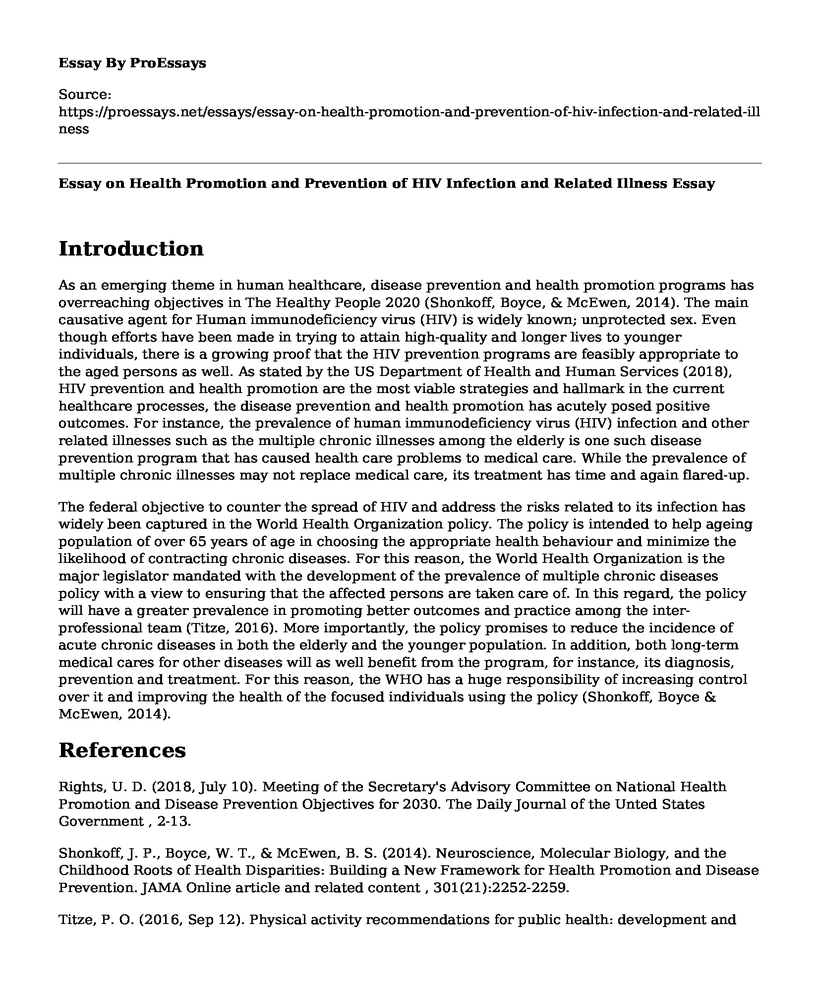Introduction
As an emerging theme in human healthcare, disease prevention and health promotion programs has overreaching objectives in The Healthy People 2020 (Shonkoff, Boyce, & McEwen, 2014). The main causative agent for Human immunodeficiency virus (HIV) is widely known; unprotected sex. Even though efforts have been made in trying to attain high-quality and longer lives to younger individuals, there is a growing proof that the HIV prevention programs are feasibly appropriate to the aged persons as well. As stated by the US Department of Health and Human Services (2018), HIV prevention and health promotion are the most viable strategies and hallmark in the current healthcare processes, the disease prevention and health promotion has acutely posed positive outcomes. For instance, the prevalence of human immunodeficiency virus (HIV) infection and other related illnesses such as the multiple chronic illnesses among the elderly is one such disease prevention program that has caused health care problems to medical care. While the prevalence of multiple chronic illnesses may not replace medical care, its treatment has time and again flared-up.
The federal objective to counter the spread of HIV and address the risks related to its infection has widely been captured in the World Health Organization policy. The policy is intended to help ageing population of over 65 years of age in choosing the appropriate health behaviour and minimize the likelihood of contracting chronic diseases. For this reason, the World Health Organization is the major legislator mandated with the development of the prevalence of multiple chronic diseases policy with a view to ensuring that the affected persons are taken care of. In this regard, the policy will have a greater prevalence in promoting better outcomes and practice among the inter-professional team (Titze, 2016). More importantly, the policy promises to reduce the incidence of acute chronic diseases in both the elderly and the younger population. In addition, both long-term medical cares for other diseases will as well benefit from the program, for instance, its diagnosis, prevention and treatment. For this reason, the WHO has a huge responsibility of increasing control over it and improving the health of the focused individuals using the policy (Shonkoff, Boyce & McEwen, 2014).
References
Rights, U. D. (2018, July 10). Meeting of the Secretary's Advisory Committee on National Health Promotion and Disease Prevention Objectives for 2030. The Daily Journal of the Unted States Government , 2-13.
Shonkoff, J. P., Boyce, W. T., & McEwen, B. S. (2014). Neuroscience, Molecular Biology, and the Childhood Roots of Health Disparities: Building a New Framework for Health Promotion and Disease Prevention. JAMA Online article and related content , 301(21):2252-2259.
Titze, P. O. (2016, Sep 12). Physical activity recommendations for public health: development and policy context. Springer EPMA Journal , 12-34.
Cite this page
Essay on Health Promotion and Prevention of HIV Infection and Related Illness. (2022, Jul 11). Retrieved from https://proessays.net/essays/essay-on-health-promotion-and-prevention-of-hiv-infection-and-related-illness
If you are the original author of this essay and no longer wish to have it published on the ProEssays website, please click below to request its removal:
- Framework for Game Development for Parkinson Disease Patient Using Exergames
- Essay on Healthcare Personal Values and Beliefs
- Essay Example on Patient Protection and Affordable Care Act (ACA)
- Essay Example on Opioid Crisis in Canada: 2800 Deaths in 2016
- Nurse Advocacy: Collaborative Expertise, Community Service, and Healthcare Knowledge - Essay Sample
- Essay Example on Sleep Studies in Lab Setting: Problems & Solutions
- Paper Example on Nursing Home Intangible and Tangible Resources: Advantages







